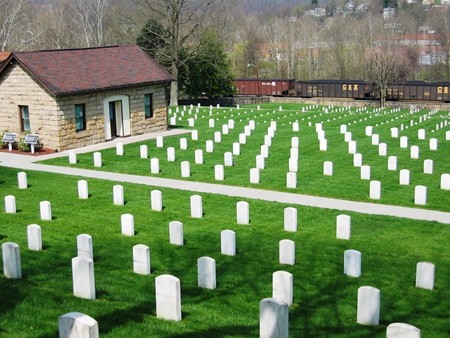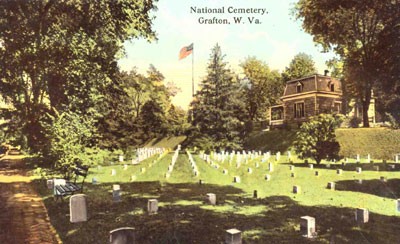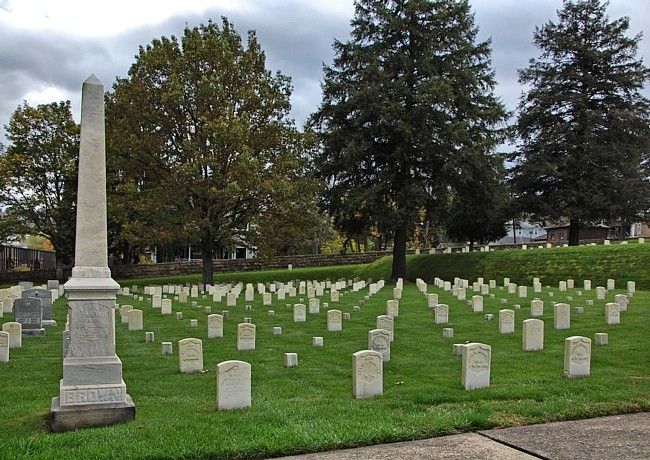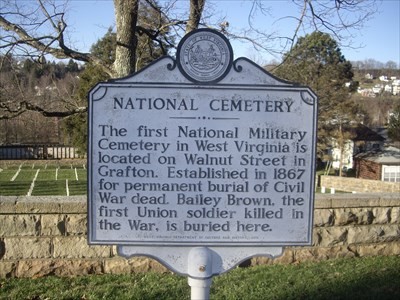Grafton National Cemetery
Introduction
Text-to-speech Audio
Images
Grafton National Cemetery

Photograph courtesy of the National Cemetery Administration History Program.

Monument to Thornsberry Brown in the Grafton National Cemetery.

WV Historical Marker

Backstory and Context
Text-to-speech Audio
The Grafton National Cemetery is the final resting place for 2,100 United States veterans. The veterans buried in this cemetery fought in any conflict between the Civil War and the Vietnam War. Besides being a Veteran, the spouse of the Veteran or their child that is not capable of living on their own were able to be buried next to the Veteran. The east and west sides of the cemetery provide a place for grave markers to represent the men lost at sea or whose remains were never recovered. A United States flag flies in the middle of the cemetery.
The administration of Abraham Lincoln authorized the National Cemetery system in response to the growing numbers of Civil War dead on battlefields across the nation. Congress passed legislation in 1862 that authorized the President to secure grounds for the burial of soldiers who died in service to the United States. Under this act three existing cemeteries were designated as national cemeteries and nine other cemeteries were established. These original national cemeteries were all located within Union-held territory, and largely were near recruiting, training, or hospital complexes where the burial of the dead could be carried out in a more orderly fashion. Early battlefield cemeteries were established at Gettysburg and Antietam, but the reburial of the Union dead into national cemeteries largely occurred once the war was over. At the end of the Civil War less than 30% of the Union dead were properly buried. Between 1866 and 1867 the Federal Government directed nation-wide efforts to locate, identify, and reinter Union remains into newly established national cemeteries. Now a Union state, West Virginia lobbied for their own national cemetery to bury the Union dead that lay within the state borders.
In 1867, the War Department ordered Major R. C. Bates to locate property for a national cemetery in West Virginia after a campaign by the state’s governor Arthur I. Boreman. He located three acres in Grafton that were relatively level (they would have to terrace the land to create burial plots), was located near the Baltimore & Ohio Railroad (for ease of transporting remains to the cemetery), and was close to the Maple Ave Cemetery where many Union soldiers were already interred. The ground was leveled into three terraces separated by a walkway that allowed entrance into the cemetery from both the street and the railroad. The Civil War burials were largely placed on the lower two terraces. 1,252 Union soldiers were reburied in the Grafton National Cemetery; about half of the burials came from temporary graves in Clarksburg and the rest were transported from Wheeling, Rich Mountain, Fayette, Marion, Kanawha, and Grant Counties, and Kentucky. 613 of the soldiers are buried as unknown, but every grave is marked by an individual marker.
West Virginia’s first governor, Arthur I. Boreman, dedicated the cemetery on June 14, 1868. Grafton had planned the dedication ceremony for May 30th because it marked the date in 1861 when Union Colonel B. F. Kelley secured Grafton prior to the Battle of Philippi and the first land engagement of the Civil War. However, poor weather and delays in burying the remains pushed the ceremonies back. Grafton’s annual “Flower Strewing Day” (now Memorial Day) typically included a parade through town, ceremonies in the cemetery, and decorating the graves with flowers. The ceremonies feature a person of importance to West Virginia and every West Virginia governor has spoken at a Memorial Day service, except for one who was only in office six days.
The most famous veteran buried in the Grafton National Cemetery is Private Thornesberry Bailey Brown. Brown was killed on May 22, 1861, prior to the battle at Philippi on June 3rd, and many consider him the first Union soldier killed in the Civil War. He enlisted into Co. B, 2nd Virginia Infantry, the “Grafton Guards” under Captain George R. Latham. According to a regimental history published in 1890 Brown and another soldier encountered Confederate pickets as they approached Fetterman. When Confederate Daniel S. Knight challenged the pair, Brown refused to stop and fired his revolver, hitting Knight in the ear. In response, Knight shot his musket, killing Brown. Brown was initially buried in a private plot but was reinterred into the National Cemetery in 1903. In 1904 the Grand Army of the Republic erected the marble obelisk that stands at Brown’s grave today. There is a second monument to Brown near the Fetterman Bridge, erected in the 1920s by the Daughters of Union Veterans of the Civil War.
The Grafton National Cemetery accepted burials of veterans from later wars as well. In the 1960s, veterans began lobbying for additional space as the Grafton Cemetery became full. In the 1970s, after studies determined that it would be difficult to expand the first cemetery, the WV United Veterans National Cemetery Committee looked for a new cemetery location. In 1987 the West Virginia National Cemetery was dedicated and has been open to burials largely from Vietnam to today. WV Senator Robert C. Byrd was instrumental in establishing the new National Cemetery and spoke there in 1991 once construction was finally complete.
Grafton National Cemetery was placed on the National Register of Historic Places in 1982, at the time the only National Cemetery in the state. Grafton continues to hold its Memorial Day celebrations and claims “the honor of celebrating the longest ongoing Memorial Day observance in the country.”
Sources
"About Grafton." Internet Archive (archived website from http://www.graftonwv.org/aboutgrafton.html from 2010). Accessed September 14, 2020. https://web.archive.org/web/20101028144429/http://www.graftonwv.org/aboutgrafton.html.
Brumage, Jody. "Celebrating Memorial Day at Grafton National Cemetery." The Byrd Center Blog. Accessed September 14, 2020. https://www.byrdcenter.org/byrd-center-blog/celebrating-memorial-day-at-grafton-national-cemetery.
"Grafton National Cemetery." National Cemetery Administration, U.S. Department of Veterans Affairs. Accessed September 14, 2020. https://www.cem.va.gov/cems/nchp/grafton.asp.
"Grafton National Cemetery." Internet Archive (archived website from http://www.cem.va.gov/pdf/grafton.pdf from 2010). Accessed September 14, 2020. https://web.archive.org/web/20100527135557/http://www.cem.va.gov/pdf/grafton.pdf.
"Grafton National Cemetery." National Park Service, U.S. Department of the Interior. Accessed September 14, 2020. https://www.nps.gov/nr/travel/national_cemeteries/West_Virginia/Grafton_National_Cemetery.html.
"National Register of Historic Places Inventory--Nomination Form: Grafton National Cemetery." West Virginia Department of Arts, Culture, and History. Accessed September 14, 2020. http://www.wvculture.org/shpo/nr/pdf/taylor/82004330.pdf.
"Timeline of West Virginia: Civil War and Statehood, May 22, 1861." West Virginia Department of Arts, Culture and History. Accessed September 14, 2020. http://www.wvculture.org/history/sesquicentennial/18610522.html.
"West Virginia National Cemetery." National Cemetery Administration, U.S. Department of Veterans Affairs. Accessed September 14, 2020. https://www.cem.va.gov/cems/nchp/westvirginia.asp.
U.S. Department of Federal Affairs. National Cemetery Administration. N.p., n.d. Web. 28 May 2014. . National Park Service U.S. Department of the Interior. Civil War Era National Cemeteries: Honoring Those Who Served. N.p., n.d. Web. 28 May 2014.
Administration, National Cemetery. “National Cemetery Administration.” West Virginia National Cemetery - National Cemetery Administration, 5 May 2015, www.cem.va.gov/cems/nchp/westVirginia.asp.
"Grafton National Cemetery." National Cemetery Administration, U.S. Department of Veterans Affairs. Accessed September 14, 2020. https://www.cem.va.gov/cems/nchp/grafton.asp.
"Grafton National Cemetery." National Park Service, U.S. Department of the Interior. Accessed September 14, 2020. https://www.nps.gov/nr/travel/national_cemeteries/West_Virginia/Grafton_National_Cemetery.html.
Photo by Ben Prepelka. "Grafton National Cemetery." Scenic USA--West Virginia. Accessed September 14, 2020. https://scenicusa.net/111111.html.
"National Cemetery." Waymarking.com. Accessed October 7, 2020. https://www.waymarking.com/waymarks/WMG6QF_National_Cemetery.
